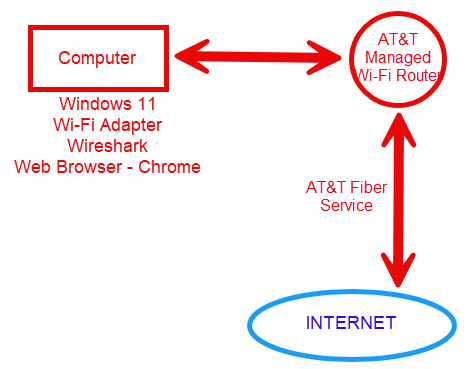When you run a speed test, you are testing several key aspects of your internet connection.
The purpose is to measure the performance of your connection to the internet in terms of download speed, upload speed, latency or delay, and jitter or delay variation.
The problem is that not all speed tests are equal. In our article on the available speed test sites, we provide some testing sites you can use. The problem is that we got different answers, but we will get to that later.
Generically, these tests provide an overview of how well your internet connection can handle various tasks, such as streaming, gaming, or downloading files. Here’s a breakdown of what each part of a speed test measures and some definitions of terms:
1. Download Speed
Download speed is the rate at which data is transferred from the internet to your device. It is usually measured in megabits per second (Mbps). This metric is crucial for activities like:
- Streaming video or music
- Downloading files
- Browsing the web
How it is measured: The speed test server sends a block of data to your device. The test calculates how long it takes for your device to receive the data and uses that time to estimate the download speed. The test may perform this action multiple times to account for fluctuations in network performance.
- What you’re testing: The capacity of your internet connection to receive data from an external source (the server) at any given time. Higher download speeds allow for faster loading of web pages, streaming without buffering, and quicker file downloads.
2. Upload Speed
Upload speed is the rate at which data is sent from your device to the internet, also measured in megabits per second (Mbps). It’s important for activities like:
- Uploading files to cloud storage or sharing photos and videos
- Video conferencing (Zoom, Skype, etc.)
- Online gaming
How it is measured: The speed test server sends a request for your device to upload a block of data back to the server. Similar to download speed, the test measures how long it takes for the data to be transmitted and calculates the upload speed based on the time taken.
- What you’re testing: The capacity of your internet connection to send data from your device to the server. Higher upload speeds are important for tasks that require sending data, such as video calls or uploading large files.
3. Latency or Delay (Ping)
Latency or delay is the time it takes for a signal (data packet) to travel from your device to the server and back, usually measured in milliseconds (ms). Milliseconds are 1000’ths of a second. For reference a normal eye blink takes about 100ms. Latency is often referred to as a ping.
- How it is measured: The speed test server sends a small packet of data to your device and immediately requests a response. The time it takes for the data to make a round trip is measured as latency.
- What you’re testing: The responsiveness of your internet connection. Low latency means that data can travel back and forth more quickly, which is important for real-time applications like:
- Online gaming
- Video conferencing
- Voice-over-IP (VoIP) services
Lower latency is better because it means less delay between actions and responses. For instance, in gaming, high latency can result in lag, making the experience less enjoyable.
Keep in mind that the further away from your location the destination is, the longer the latency will be. For example pinging an IP address that is in your home or close to your home town will be fast, whereas pinging a service half way around the world in India from the United States will be much slower by comparison.
4. Jitter
Jitter refers to the variation in delay, or the variation in the time it takes for data packets to travel across the network. It is also measured in milliseconds (ms).
- How it is measured: During a speed test, multiple packets of data are sent to your device and back to the server. Jitter is calculated by measuring the variations in the latency of these packets over time.
- What you’re testing: The stability and consistency of your connection. High jitter means that data packets are arriving with inconsistent delays, which can lead to issues in applications that require real-time, consistent data flow, such as:
- Video streaming (e.g., buffering or quality drops)
- Online gaming (e.g., lag spikes)
- Video or voice calls (e.g., choppy or delayed audio)
5. Packet Loss (in some, not all speed tests)
Some speed tests also check for packet loss, which is the percentage of data packets that are lost during transmission. Packet loss can severely affect the performance of real-time applications like gaming and video conferencing.
- How it is measured: The test sends multiple packets of data and checks if any are dropped or lost in transit. If packets don’t make it to their destination, it is counted as packet loss.
- What you’re testing: The reliability of your connection. High packet loss can cause interruptions, drops in calls, or freezes in online games.
Summary of What the Speed Test Measures:
- Download Speed: How fast your internet connection can pull data from the internet to your device.
- Upload Speed: How fast your internet connection can send data from your device to the internet.
- Latency (Ping): How quickly data travels from your device to the server and back.
- Jitter: How stable your connection is, measured by fluctuations in latency.
- Packet Loss (if applicable): The percentage of data packets that fail to reach their destination.
Factors That Influence Speed Test Results
A number of factors can affect your speed test results, including:
1. The Distance to the Server
Speed tests connect to a server, usually geographically close to your location, to measure the speed. If the server is far away, the test might show higher latency and slightly slower speeds due to the increased time it takes for data to travel over a longer distance.
2. Network Congestion
If the speed test is being conducted during peak hours, when many users are sharing the network, the test results might be slower due to congestion. ISPs sometimes throttle speeds during high-usage times to manage traffic.
3. Wi-Fi vs. Wired Connection
If you’re running the speed test over Wi-Fi, the results might be slower compared to a wired Ethernet connection. Wi-Fi signals can be affected by distance, interference from other devices, and the quality of your router. A direct wired connection usually provides more accurate and faster results.
4. The Performance of Your Device
Older or slower devices may struggle to keep up with high-speed connections, especially during a speed test. Additionally, if you have background applications or downloads running, they could impact your test results.
5. ISP Network Management
ISPs sometimes implement traffic shaping, which means they might prioritize certain types of traffic over others (e.g., video streaming versus browsing) or throttle certain activities during periods of high network demand. This can influence your test results.
6. Test Protocol
The test protocol being used can affect results. For example, some tests use TCP (Transmission Control Protocol), which adds reliability overhead, while others may use UDP (User Datagram Protocol), which can deliver faster results but with less error checking.
General Speed Testing Conclusions
When you run a speed test, you’re testing several components of your internet connection:
- Download speed tells you how quickly you can receive data.
- Upload speed shows how quickly you can send data.
- Latency (ping) measures the responsiveness of your connection.
- Jitter reveals the consistency of your connection.
- Packet loss (if measured) tells you how reliable your connection is.
These metrics provide a good indication of the overall health and performance of your internet connection and can help identify issues like slow speeds, high latency, or inconsistent performance.
Testing Results
Recall that at the beginning of this post, we said there are a number of test sites that we listed here. We ran the tests and below is a summary of our results.
In order to make the results as “apples to apples” as possible, we used the same computer, connected to the same network, the same way. We minimized any other traffic on the local network. All tests were run within 30 minutes on a single day (Monday mid-morning). The rest is out of our control.
Test Setup
Here is our test setup:

Chart of Results
| Test Site | Download Speed | Upload Speed | Latency | Jitter | |
| 1 | speedtest.net | 103.36 Mbps | 31.49 Mbps | 8 ms | Not reported |
| 2 | Google Speed Test | 108.3 Mbps | 30.8 Mbps | 5 ms | Not reported |
| 3 | Fast.com | 89 Mbps | 24 Mbps | Not reported | Not reported |
| 4 | nperf | 135.9 Mbps | 15.92 Mbps | 6.7 ms | 3.8 ms |
| 5 | Testmy.net | 59.9 Mbps | 7.9 Mbps | 23.7 ms | 7.5 ms |
| 6 | Speedofme | 56.54 Mbps | 6.07 Mbps | 12 ms | Not reported |
| 7 | Mlab | 103.07 Mbps | 20.88 Mbps | 5 ms | Not reported |
| 8 | OpenSpeedTest | 160.71 Mbps | 35.3 Mbps | 6.6 ms | .4 ms |
| 9 | Xfinity | 89.4 Mbps | 15.8 Mbps | 19 ms | Not reported |
Trying to step back from these numbers, here is what we see:
- None are the same, so the conclusion is that they all use slightly different ways to do their tests or there is deviation from one moment to the next oon the Internet. We know the latter is true. But we will have to dig deeper to understand if they operate differently. Luckily we captured the packets for each of these tests and will provide our analysis in a later article.
- Some are similar – the first two are very close. Number 3 and 9 are similar in download speeds. Number 5 and 6 are also the low measurements and are somewhat similar.
- The best is #8.
- The worst is #6.
These results underscore why I dislike speed testing so much. The answers can be all over the place, and the factors discussed above can make huge differences in test results. The results are not predictable. This is a problem for Service Providers and Customers alike. How do you explain all this? These are questions we will deal with as we continue down the Speed Test rabbit hole.
Comments are welcomed below from registered users. You can also leave comments at our Discord server.
If you would like to see more content and articles like this, please support us by clicking the patron link where you will receive free bonus access to courses and more, or simply buying us a cup of coffee!

